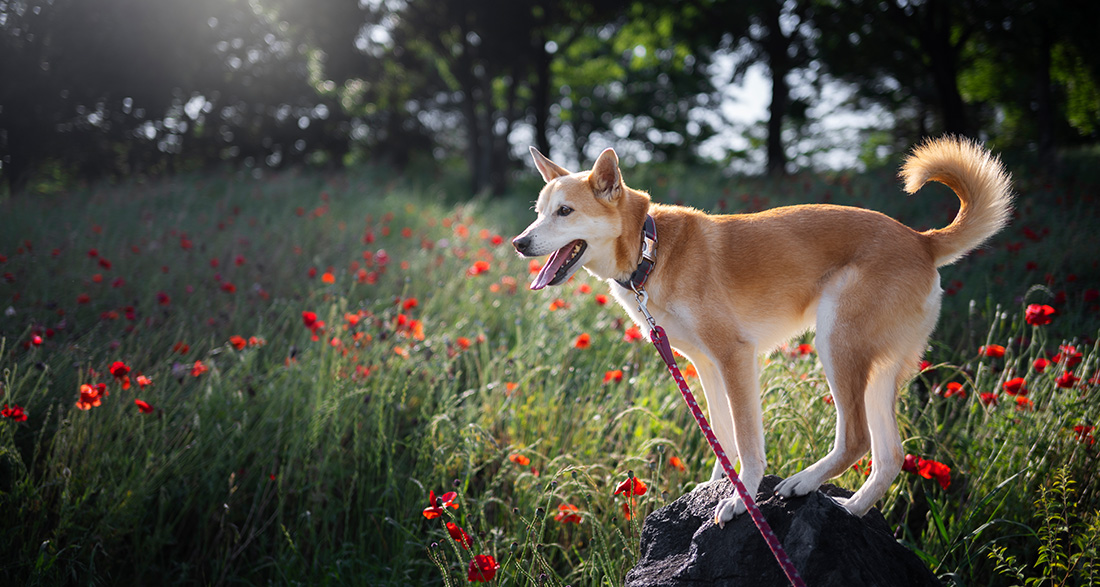Do you think your dog is allergic to pollen? If he starts scratching more after walks this spring, you could be right. But what are the exact symptoms? And what measures can you take to help your furry friend feel better quickly?
Many humans can’t fully enjoy spring and summer due to flying grasses and pollen. What many don’t know is that some dogs also react allergically to pollen. Canine hay fever is usually not recognized as quickly and is not immediately associated with airborne grasses.
Dog is allergic: Blame it on changed living conditions
Allergies in dogs often go undetected for a long time – probably because we don’t even consider the possibility that our pets could be allergic to pollen. However, they are increasingly developing intolerances – in recent decades, allergies have increased not only in us humans but also in our four-legged friends. The changed living conditions of the modern world are to blame. This includes a changed way of keeping animals.
In the past, our furry friends were more like farm dogs than household pets, and back then, they came into contact with very different germs than they do now when they only go outside for daily walks. It is believed that their immune system has become somewhat “unemployed” due to the generally very good hygiene conditions today, making it more prone to overreactions to usually non-pathogenic stimuli.
Dog is allergic: the symptoms
You’re probably wondering how to recognize if your furry friend is allergic to pollen? The allergy mainly manifests itself on your dog’s skin. If your four-legged companion starts scratching more after walks or if the skin on the face, belly, and paws wears off, you should pay attention. Allergies in dogs almost always manifest through itching and accompanying skin rashes. The symptoms of the allergy usually worsen in spring, which is a clear sign that the dog is reacting to pollen. It’s a vicious circle because constant scratching and biting at their own body to alleviate itching can cause the skin to redden, irritate, and leave bald spots in the fur.
Red eyes and a runny nose can occur in dogs, but that is rather rare. Breathing problems are even rarer. However, if they occur, they are very serious. Because the release of histamines due to an allergic immune reaction causes the dog’s respiratory tract mucous membranes to swell, leading to wheezing or, in the worst case, difficulty breathing. In such cases, you must act immediately because swelling of the airways poses an acute risk of suffocation for your dog.
Tip:
Some dogs develop conjunctivitis, especially in spring. If there is also an allergic skin irritation at the same time or earlier, always consider that this conjunctivitis may be a result of pollen allergy.
Dog is allergic to pollen – What you can do
One could recommend keeping your furry friend indoors as much as possible during hay fever season and minimizing walks. But let’s be honest, that doesn’t pass the practical test. The following measures, however, can genuinely help alleviate your four-legged friend’s suffering:
- Keep the fur short: Pollen directly adhere to the fur of dogs that frequently run through grass. For long-haired breeds, we recommend keeping the fur short so that fewer pollen can stick to it.
- Cold shower: It is also advisable to shower the four-legged friend with cold water after each walk to clean paws and belly.
- Shampoo: For particularly sensitive dogs, washing 1-2 times a week with an antiallergenic shampoo can already provide relief from symptoms.
Avoid tall, blooming meadows. - Keep the lawn short: If you have a garden, keep the lawn short. Do not let your furry friend into the garden while mowing the lawn, as a lot more pollen flies around.
- Rinse eyes with water: You can rinse red dog eyes with lukewarm water after consulting with the vet. Do not use chamomile tea, as it dries out the dog’s skin.
- Wash sleeping pillow: Pollen like to settle in the fabric fibers of the dog bed. Washing it thoroughly once a week makes sense to remove any embedded pollen.
- Washable toys: To prevent pollen from sticking to toys, leave fabric animals and tennis balls at home and instead take rubber balls or plastic chew and throw toys outside.
If these measures do not help, you may have to resort to stronger measures. An allergy test at the vet can provide information on exactly which grasses and pollens your dog is allergic to. However, the so-called prick test is not a bargain, ranging between $150 and $250.
Dog is allergic – Allergy therapy provides relief
Once the vet has identified which pollens trigger a reaction in your dog, allergy therapy, a combination of avoidance, desensitization, and medications to relieve itching, is the next step. But keep in mind: an allergy is usually not curable. It can only be treated to the extent that your dog can live relatively symptom-free.
The entire treatment is relatively lengthy because desensitization can take some time. In this treatment method, the animal is injected with tiny amounts of the allergen under the skin at certain intervals, and this dose is increased up to a certain maximum amount. Once this maximum amount is reached, it is maintained but injected at longer intervals. Dogs tolerate this treatment very well, but it must be carried out over several months, often even years, potentially lifelong.
Dog is allergic – some breeds are more vulnerable
Since allergies are usually hereditary, passed from parents to children, there are dog breeds that have a greater predisposition to allergies than others. Labrador, French Bulldog, Boxer, Golden Retriever, and various Terrier breeds often react particularly allergically. Therefore, it is worthwhile to take out pet insurance for these breeds at a young age. Since allergies in dogs usually occur after the first year of life, you then have someone who covers the not exactly low therapy costs.


